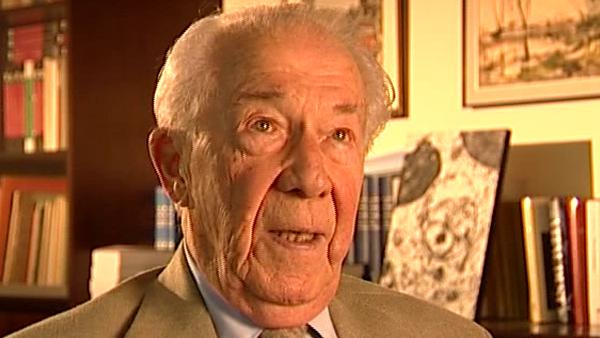NEXT STORY

Becoming weary of teaching and administrative duties
RELATED STORIES

NEXT STORY

Becoming weary of teaching and administrative duties
RELATED STORIES


|
Views | Duration | |
|---|---|---|---|
| 51. The first lysosomal storage disease | 126 | 04:29 | |
| 52. Dame Honor B Fell and vitamin A | 79 | 03:49 | |
| 53. 'Pericanalicular dense bodies' | 99 | 02:55 | |
| 54. Alex Novikoff | 196 | 05:25 | |
| 55. Uricase: Not a typical enzyme | 109 | 02:31 | |
| 56. Peroxisomes | 1 | 162 | 05:20 |
| 57. Becoming weary of teaching and administrative duties | 131 | 03:59 | |
| 58. Joining the Rockefeller Institute | 100 | 02:59 | |
| 59. A dual life between New York and Louvain | 121 | 04:01 | |
| 60. Jacques Berthet and Miklós Müller | 169 | 05:16 |


Well, continuing the analytical work by using different techniques, eventually we became able to show that those three enzymes belonged to a different kind of particle that could not be separated from lysosomes by sedimentation. They sediment about the same speed as lysosomes but they could be separated by differences in density. This is a different kind of technique in which you create a so-called gradient or density gradient in a test tube – that is... in a test tube or in whatever – but it's a system in which the density of the fluid increases from top to bottom. The machines can be used to do that and so you have a gradient – a density gradient. And if you layer some material on top of that gradient and you centrifuge for a long time, then what happens is that the particles that you've layered will sediment down up to the time they reach a layer of their own density. Then, of course, they will stop and so you can separate... by this way you can separate particles on the basis on their density. The lighter particles will stop earlier, the denser particles will be found later, but this is not sedimentation, it's equilibration, because you can go on, they won't move anymore; they will just stay where they are. And so we developed those techniques and found that in sucrose gradient lysosomes would be at lighter level than the particles containing catalase, uricase, D-amino acid oxidase, which we could separate from the lysosomes by this technique. So we finally got the proof that those enzymes and many others were added to the family, belong to particles that were, again, different from mitochondria and microsomes, but also from lysosomes and, because of the hydrogen peroxide connection, I called them peroxisomes, and that name appeared in print for the first time in 1965. And at first peroxisomes did not excite us very much. Oh yes, I will say that in the electron microscope purified preparations of these particles could be identified as bodies that microscopists had called microbodies, so again, we went from the chemical analysis to the final identification in the electron microscope. So the peroxisomes didn't attract much attention at that time because we were so involved with lysosomes but eventually we, in fact, went on to do a lot of work on peroxisomes. We studied the biosynthesis of the particles; we found more enzymes in the particles, and other people in our lab, and also in other labs, discovered similar particles in unicellular organs and protozoa, in plant cells – in leaves and so on. And it turns out that peroxisomes are also universally distributed in all eukaryotic cells they are constituents of the cells like... like lysosomes. And they had very interesting functions. They are very much involved in the fatty acid oxidisation; they are involved, especially in lower organisms, in the conversion, and in plants, in the conversion of fatty acids to carbohydrate and in a number of amino acid metabolism and in another... other metabolic processes. And peroxisomes also are involved in a number of genetic diseases. A number of diseases had been discovered... had been discovered in which some peroxisomal enzyme is missing or in which the assembly of peroxisomes is inhibited for some reason or another, and so here again, this discovery has provided a lot of valuable information to our understanding of the physiology of cells and also to pathology.
Belgian biochemist Christian de Duve (1917-2013) was best known for his work on understanding and categorising subcellular organelles. He won the Nobel Prize in Physiology or Medicine in 1974 for his joint discovery of lysosomes, the subcellular organelles that digest macromolecules and deal with ingested bacteria.
Title: Peroxisomes
Listeners: Peter Newmark
Peter Newmark has recently retired as Editorial Director of BioMed Central Ltd, the Open Access journal publisher. He obtained a D. Phil. from Oxford University and was originally a research biochemist at St Bartholomew's Hospital Medical School in London, but left research to become Biology Editor and then Deputy Editor of the journal Nature. He then became Managing Director of Current Biology Ltd, where he started a series of Current Opinion journals, and was founding Editor of the journal Current Biology. Subsequently he was Editorial Director for Elsevier Science London, before joining BioMed Central Ltd.
Tags: 1965
Duration: 5 minutes, 20 seconds
Date story recorded: September 2005
Date story went live: 24 January 2008